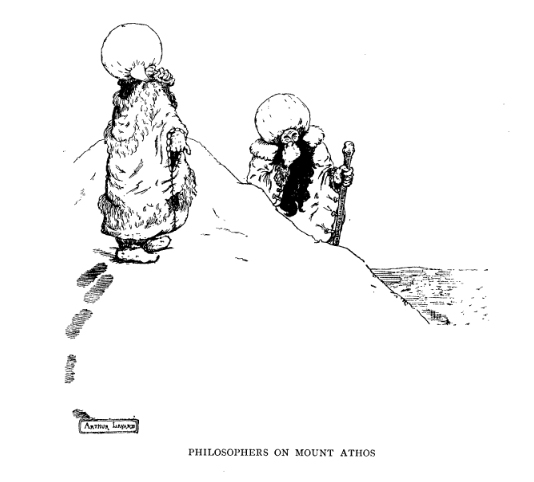Mount Athos that passeth the clouds.
“The Voiage and Travaile of Sir John Mandeville”, knight of St. Albans was a very popular travel book in the fourteenth century. The real identity of the author, Sir John Mandeville, is still unclear. He might have been a monk from Liège. The book inspired Christopher Columbus, he took it with him on his adventurous travels. Some claim that the book was inspired by Marco Polo.
It is a tale of a pilgrimage to the Holy Land and the Sinai (and far beyond to Egypt, India, Indonesia, and the Far East). In fact the whole, then known, world is covered. The long travels, it took more than 30 years and lead him also to Mount Athos and Mount Olympus. The book is well known for its inaccuracies as we will see. The author probably never left Western Europe and used all kinds of different secondary sources. There is no mention of any monastic life on Athos.
It was written in medieval Anglo-Normandic, and translated in all the west-European languages. The most translated book of its time, except for the Bible. In 1895 a modern English version was published. The illustrations in this version are by Mr. Arthur Layard.

The ”Saint Sophia“ in Constantinople is described as the most noble church of the World. After mentioning the philosopher Aristoteles, who was born in Stagyra, on Chaldikidi, the work continues:
“In this Country be right high Hills, toward the End of Macedonia. And there is a great Hill, that man call Olympus, that parteth Macedonia and Thrace. And it is so high that is passeth the Clouds. And there is another Hill, that is clept Athos, that is so high, that the Shadow reacheth to Lemne, that is an Isle, and it is 67 miles between. And above at the top of the Hill is the Air so clear, that man may find no Wind there, and therefore may no Beast live there; and so is the Air dry.”
And then follows in de Medieval version:
And Men seye in theise Contrees, that Philosophres som tyme wenten upon theise Hilles, and helden to here Nose a Spounge moysted with Watre, for to have Eyr; for the Eyr above was so drye. And aboven, in the Dust and in the Powder of tho Hilles, thei wroot Lettres and Figures with hire Fingres: and at the zeres end thei comen azen, and founden the same Lettres and Figures, the whiche thei hadde writen the zeer before, withouten ony defaute.
(And Men say in these Countries, that Philosophers some time went upon these Hills, and held to their Noses a Sponge moisted with Water, to have Air; for the Air above was so dry. And above, in the Dust and in the Powder of those Hills, they wrote Letters and Figures with their Fingers. And at the Year’s End they came again, and found the same Letters and Figures, the which they had written the Year before, without any Default.)
This passage is followed by a theological description of the differences between the Roman Catholic and the Orthodox faith.
Monks or astronomers, writing letters in the dust is already shown in this post. That picture is drawn from an later fifteenth century medieval version of the Mandeville book. There have been many versions of this work.
Much later Pilgrim Herman proved that there is at least birdlife on the top of Mount Athos. And despite the warnings we reached the dry summit of the Holy Mountain in 2011 without the help of watery sponges or other aids. The philosophers were gone. We didn’t see any on the top.
The book can be downloaded for free via the Project Gutenberg: http://www.gutenberg.org/ebooks/782
Bas Kamps
